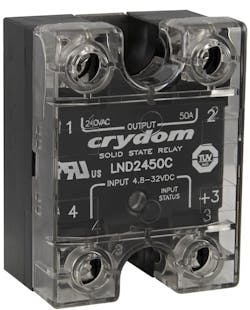Applying Low-Noise Solid-State Relays to Limit EMI: A Comprehensive Guide
Electromagnetic interference (EMI) is a pervasive challenge in the realm of modern electronics, influencing the performance, reliability and compliance of numerous devices. As industries continue to push the boundaries of electronic innovation, the need to mitigate EMI becomes increasingly critical. Solid-state relays (SSRs) offer unique advantages over traditional electromechanical relays (EMRs), but also present distinct challenges related to EMI.
This comprehensive guide explores the application of specialized low-noise SSRs to limit EMI, delving into their features, benefits and specific use cases.
The Role of Solid-State Relays (SSRs)
In a traditional EMR, a low-power circuit energizes a coil, creating a magnetic field which then physically closes the contacts and allows the high-power circuit to flow. Solid-state relays are electronic switching devices that use semiconductor components to switch on or off when an external voltage is applied.
READ MORE: Teaching an Old Sensor New Tricks
Unlike EMRs, SSRs have no moving parts, which provides several benefits:
- Increased reliability. With no mechanical parts to wear out, SSRs typically have a longer lifespan. SSRs are known to last for millions of operations while EMRs often last in the range of 100,000-500,000 operations or slightly above when heavily derated. Obviously, the life expectancy of EMRs depends on the quality of materials and can be further increased at an additional cost. A frequent practice to increase life expectancy of EMRs is oversizing the ratings of the contacts, which in turn increases cost of the part as well.
- Faster switching speeds. SSRs can switch much faster than EMRs, which is crucial for many modern applications. Instantaneous turn-on solid state relays and contactors respond to a control signal in less than 100 μs.
- Shock and vibration resistant. Because they are not reliant on any moving components, solid state switching solutions are not susceptible to erratic or unreliable operation when operating under tough environments.
- Silent operation. Solid state switching solutions make no acoustical noise when the output contacts change state. This is highly desirable in many commercial and medical applications.
- No arcing. SSRs generate no sparks arcs when opening or closing, and do not bounce electrically or mechanically, making them well-suited for hazardous environments.
One of the drawbacks of SSRs is driven by their nature as a semiconductor—specifically in terms of heat. When the SSR is on, resistance within the circuit causes power dissipation and heat build-up, which—depending on the application—may necessitate the inclusion of a heat sink, thus increasing the size of the solution. Many SSRs are sold with integral heat sinks, which helps reduce the complexity in managing heat dissipation across a specific application.
The fast-switching nature of SSRs can also generate high-frequency noise, contributing to EMI. This is where specialized low-noise SSRs come into play.
Understanding EMI and its Impact
EMI is the disturbance generated by an external source that affects an electrical circuit. This interference can degrade the performance of the circuit, lead to data loss or cause total device failure.
EMI can originate from various sources, including power lines, radio transmitters and even other electronic devices. In industrial settings, the consequences of EMI can be particularly severe, affecting precision machinery, communication systems and sensitive medical equipment.
Key Features of Low-Noise SSRs
To mitigate the EMI generated by fast switching, low-noise SSRs incorporate a variety of approaches, such as shielding and filtering. But the circuit design itself plays a significant role.
First, using relays with a silicon-controlled rectifier (SCR) output is an initial step in looking to minimize EMI. But when looking to meet standards such as IEC 60947-4-3, additional steps may be needed.
SSRs with zero-crossing detection are designed to deliver lower noise levels for resistive loads. This feature allows the relay to switch at the point where the AC voltage waveform crosses zero volts. Switching at this point eliminates inrush current and voltage spikes, significantly reducing EMI. For inductive loads, so-called random-switching SSRs are preferred. When the switch is activated, they switch instantly, rather than waiting for the AC supply to reach zero.
WATCH: Forging the Future of Defense with Modern Methodologies
SCR-based relays also have the advantage of a faster dv/dt characteristic when compared with a triac relay—especially when the relay is not activated. By way of comparison, SCRs have a dv/dt of around 500 volts/microsecond (volts/µs)—compared to 10 volts/µs for a triac—and will not conduct after the zero-crossing point. Because the components are also spread wider within the device, they will generally deliver slightly better heat dissipation.
An example of these types of SSRs can be seen in Sensata’s LN series of relays, which incorporate a low noise trigger circuit designed to help use of additional EMI filter.
The LN Series offers ratings up to 75 Amps at 528VAC in standard panel mountable hockey-puck style device with Integrated input/output overvoltage protection. It is also available with standoffs for PCB mounting if needed, and is UL recognized and TUV certified.
Some key applications where the LN series has been well-suited include commercial ovens, household appliances and medical equipment.
Benefits of Low-Noise SSRs
The implementation of low-noise SSRs offers several benefits across various industries where EMI is most challenging, such as medical devices, telecommunications or industrial automation equipment.
While more expensive than EMRs, solid state relays deliver the wear-free operation needed in today’s digital electronic landscape. By reducing EMI, these SSRs also ensure that sensitive electronic equipment operates more reliably and efficiently and potentially deliver an extended lifespan as impacts on components are minimized.
Using low-noise SSRs can also help reduce or eliminate the need for an external filter, reducing cost, design complexity and space.
READ MORE: Smart Sensors: IO-Link Enables New Era for Strain Gauge Sensors
The application of specialized low-noise solid-state relays is a critical strategy for limiting EMI in various electronic systems. By incorporating features such as snubber circuits, zero-crossing detection and advanced shielding, these relays help ensure the reliable and efficient operation of sensitive equipment. As industries continue to demand higher performance and stricter compliance with EMI standards, low-noise SSRs will play an increasingly significant role in the design and implementation of modern electronic systems.
This article was submitted by Jesus Miranda, product manager for Crydom Solid State Relays, Sensata Technologies.


